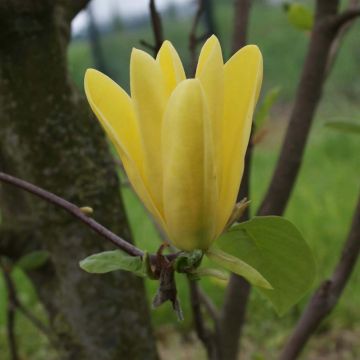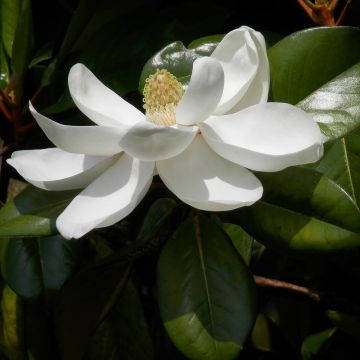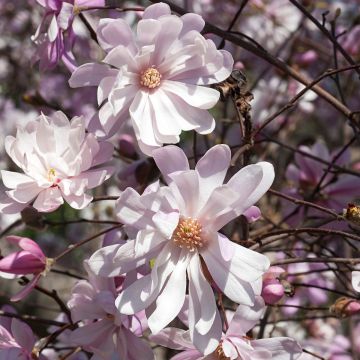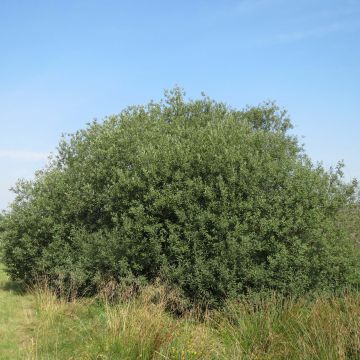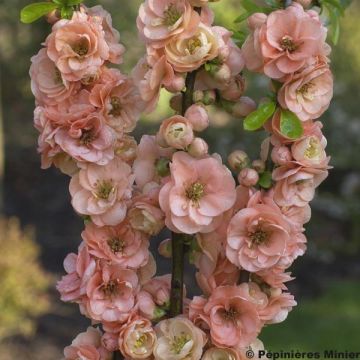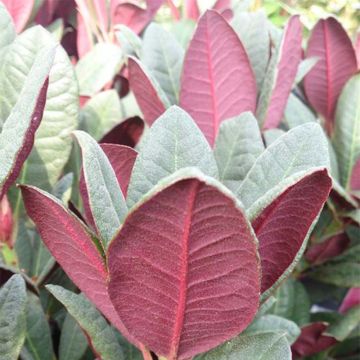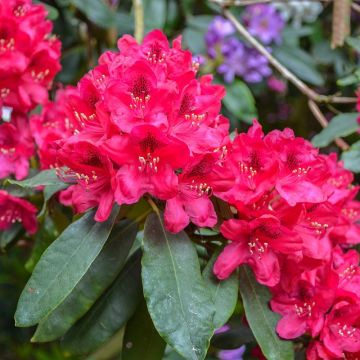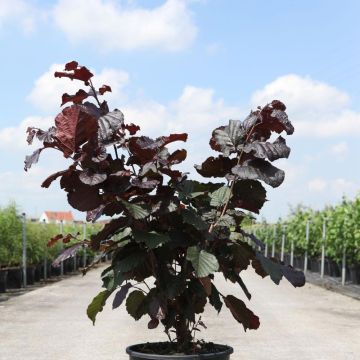

Magnolia Heaven Scent
Magnolia liliiflora x veitchii Heaven Scent
Magnolia
This item cannot be shipped to the selected country
Delivery charge from €5.90
Oversize package delivery charge from €6.90
Delivery to Corse prohibited
More information
Schedule delivery date,
and select date in basket
This plant carries a 24 months recovery warranty
More information
We guarantee the quality of our plants for a full growing cycle, and will replace at our expense any plant that fails to recover under normal climatic and planting conditions.
From €5.90 for pickup delivery and €6.90 for home delivery
Express home delivery from €8.90.
Oversize package: home delivery by special carrier from €6.90 per order..
Express home delivery from €8.90.
Delivery to Corse prohibited: UE law prohibits the import of this plant from mainland France to Corse as part of the fight against Xylella fastidiosa. Please accept our sincere apologies.
More information
Does this plant fit my garden?
Set up your Plantfit profile →
Description
The Magnolia 'Heaven Scent' is a stunning small deciduous tree with a slow growth rate, pyramidal and curved habit. In early spring, it offers an unforgettable sight with a profusion of large bright pink flowers with pale pink hearts that resemble narrow tulips. This hybrid variety bears flowers biennially from a young age, even before its light green foliage emerges. It deserves a special place in the garden but should be protected from cold winds that could damage its early flowering. The tree thrives in moist soil, in full sun or partial shade, without too much limestone.
This beautiful Magnolia is a hybrid of horticultural origin that was first obtained in 1955 in California, United States. It resulted from cross-breeding between M. veitchii and M. 'Lennei Alba', belonging to the magnolia family. The Magnolia 'Heaven Scent' forms a small tree with a central leader and slightly erect branches taller than wide. At maturity, it reaches a height of about 4 metres (13 feet 1 inch) and a width of 2 metres feet 7 inches) with rapid growth. The foliage is deciduous, comprised of light green and oval-shaped leaves with pointed tips, measuring 10 to 15 cm (3.9 to 5.9 inches) in length. This variety produces flowers from the age of 2 or 3 years. The large solitary flowers bloom from March to April before the appearance of the leaves. They are narrow and tall, in the shape of cups, measuring 12 to 15 cm (4.7 to 5.9 inches). These flowers open from buds that are protected by silky bracts and are formed by 10 to 15 waxy and thick tepals (indistinguishable sepals and petals), slightly incurved, with a bright pink colour with magenta at the base on the outside, and very pale pink on the inside. They gradually open in a star shape around a heart of numerous yellow stamens.
Magnolias are ornamental trees that thrive in small gardens and large parks. It is often used as a standalone specimen in the middle of a lawn, where its remarkable flowering is most effective. You can also pair it with other interesting shrubs at different times of the year, such as maple, roses, Hibiscus syriacus, Prunus x subhirtella 'Autumnalis', or Cornus kousa Satomi. Additionally, it blends well with acid-loving plants like rhododendrons, camellias, hydrangeas, nandinas, and peonies, making it perfect for a Japanese-style garden. You can also create beautiful flowering hedges along pathways by alternating this magnolia with other cultivars like Magnolia grandiflora or Magnolia denudata. As its root system is not dangerous for foundations, it can be planted against a house wall.
Magnolias are considered ancient trees, with fossils dating back over 20 million years. Their magnificent flowering is considered one of the most primitive, as they are evolutionarily close to the first existing flowers. The bark of magnolias is also believed to possess medicinal properties and is used in cosmetics. Additionally, their wood is considered precious.
Report an error about the product description
Magnolia Heaven Scent in pictures




Plant habit
Flowering
Foliage
Botanical data
Magnolia
liliiflora x veitchii
Heaven Scent
Magnoliaceae
Magnolia
Cultivar or hybrid
Other Magnolia
Planting and care
The 'Heaven Scent' magnolia is a delicate plant vulnerable to late frosts. It grows best in sheltered areas with good sunlight but not too much exposure. The soil should be cool, well-drained, rich, and slightly acidic. This plant can tolerate slightly chalky soils, but too much can be harmful. It doesn't do well in excessively dry soils, windy locations, or areas with root competition since its root system is shallow. While it can withstand temperatures as low as -15°C, protecting young plants from frost in the first few years after planting is advisable. It's important to note that late frosts and cold winds can damage flower buds and young leaves, affecting flowering.
To plant Magnolia successfully, find a spot in either spring or autumn, sheltered from cold winds and outside the frost period. Dig a hole 80 cm (31.5 inches) wide and deep with a good supply of ericaceous soil and compost. Be careful not to damage the plant's delicate roots when putting it in the hole. Water the plant immediately with low limestone (like rainwater) to compact the soil around the roots. Water the plant once a week during its first year after planting. Mulch the base of the plant to keep it cool during hot seasons, enrich the soil, and protect it from the cold during winter.
Because Magnolia's roots are fragile, it's best to avoid transplanting. Magnolias are ornamental trees that do well in polluted areas, and their roots won't damage building foundations. Parasites like scale insects, snails, and slugs can harm young plants and diseases like rot (in excessively wet soil), coral spot, and pestalotiopsis.
Planting period
Intended location
Care
-
, onOrder confirmed
Reply from on Promesse de fleurs
Spring-flowering shrubs
Haven't found what you were looking for?
Hardiness is the lowest winter temperature a plant can endure without suffering serious damage or even dying. However, hardiness is affected by location (a sheltered area, such as a patio), protection (winter cover) and soil type (hardiness is improved by well-drained soil).

Photo Sharing Terms & Conditions
In order to encourage gardeners to interact and share their experiences, Promesse de fleurs offers various media enabling content to be uploaded onto its Site - in particular via the ‘Photo sharing’ module.
The User agrees to refrain from:
- Posting any content that is illegal, prejudicial, insulting, racist, inciteful to hatred, revisionist, contrary to public decency, that infringes on privacy or on the privacy rights of third parties, in particular the publicity rights of persons and goods, intellectual property rights, or the right to privacy.
- Submitting content on behalf of a third party;
- Impersonate the identity of a third party and/or publish any personal information about a third party;
In general, the User undertakes to refrain from any unethical behaviour.
All Content (in particular text, comments, files, images, photos, videos, creative works, etc.), which may be subject to property or intellectual property rights, image or other private rights, shall remain the property of the User, subject to the limited rights granted by the terms of the licence granted by Promesse de fleurs as stated below. Users are at liberty to publish or not to publish such Content on the Site, notably via the ‘Photo Sharing’ facility, and accept that this Content shall be made public and freely accessible, notably on the Internet.
Users further acknowledge, undertake to have ,and guarantee that they hold all necessary rights and permissions to publish such material on the Site, in particular with regard to the legislation in force pertaining to any privacy, property, intellectual property, image, or contractual rights, or rights of any other nature. By publishing such Content on the Site, Users acknowledge accepting full liability as publishers of the Content within the meaning of the law, and grant Promesse de fleurs, free of charge, an inclusive, worldwide licence for the said Content for the entire duration of its publication, including all reproduction, representation, up/downloading, displaying, performing, transmission, and storage rights.
Users also grant permission for their name to be linked to the Content and accept that this link may not always be made available.
By engaging in posting material, Users consent to their Content becoming automatically accessible on the Internet, in particular on other sites and/or blogs and/or web pages of the Promesse de fleurs site, including in particular social pages and the Promesse de fleurs catalogue.
Users may secure the removal of entrusted content free of charge by issuing a simple request via our contact form.
The flowering period indicated on our website applies to countries and regions located in USDA zone 8 (France, the United Kingdom, Ireland, the Netherlands, etc.)
It will vary according to where you live:
- In zones 9 to 10 (Italy, Spain, Greece, etc.), flowering will occur about 2 to 4 weeks earlier.
- In zones 6 to 7 (Germany, Poland, Slovenia, and lower mountainous regions), flowering will be delayed by 2 to 3 weeks.
- In zone 5 (Central Europe, Scandinavia), blooming will be delayed by 3 to 5 weeks.
In temperate climates, pruning of spring-flowering shrubs (forsythia, spireas, etc.) should be done just after flowering.
Pruning of summer-flowering shrubs (Indian Lilac, Perovskia, etc.) can be done in winter or spring.
In cold regions as well as with frost-sensitive plants, avoid pruning too early when severe frosts may still occur.
The planting period indicated on our website applies to countries and regions located in USDA zone 8 (France, United Kingdom, Ireland, Netherlands).
It will vary according to where you live:
- In Mediterranean zones (Marseille, Madrid, Milan, etc.), autumn and winter are the best planting periods.
- In continental zones (Strasbourg, Munich, Vienna, etc.), delay planting by 2 to 3 weeks in spring and bring it forward by 2 to 4 weeks in autumn.
- In mountainous regions (the Alps, Pyrenees, Carpathians, etc.), it is best to plant in late spring (May-June) or late summer (August-September).
The harvesting period indicated on our website applies to countries and regions in USDA zone 8 (France, England, Ireland, the Netherlands).
In colder areas (Scandinavia, Poland, Austria...) fruit and vegetable harvests are likely to be delayed by 3-4 weeks.
In warmer areas (Italy, Spain, Greece, etc.), harvesting will probably take place earlier, depending on weather conditions.
The sowing periods indicated on our website apply to countries and regions within USDA Zone 8 (France, UK, Ireland, Netherlands).
In colder areas (Scandinavia, Poland, Austria...), delay any outdoor sowing by 3-4 weeks, or sow under glass.
In warmer climes (Italy, Spain, Greece, etc.), bring outdoor sowing forward by a few weeks.

































